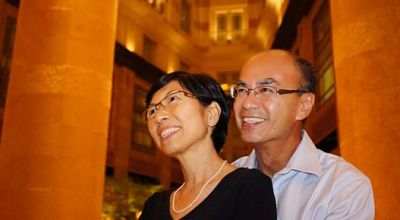Young Missionaries Advance Gospel in Asia
While Rodney Hui, Partner Ministries Director of Logos Hope, was passing through Singapore recently, Operation Mobilization took the opportunity to ask him a few questions about how missions in South East Asia has changed and how the church is responding.
As partner ministries director of Logos Hope, Hui is responsible for maintaining and developing relationships between the Operaton Mobilizaton’s ship ministry and partners, Christian leaders, pastors, donors and special visitors. Being part of the leadership team, Hui and his wife, Irene, seek to be a model to the 400 crewmembers. They enjoy being “parents” to the many young people on board and represent OM East Asia Pacific wherever they go. They have served with OM for 37 years.
As one of the first Singaporeans sent out with OM, how would you say missions has changed over the past 37 years?
Short-term missions within OM has come in full circles, at least in Singapore anyway. Since first joining OM in 1975, two generations of Singaporeans have grown up, and my generation is now encouraging their children to join OM short-term. Many of the young people who join Logos Hope grew up in OM and have since caught the vision for missions from their parents.
But interestingly, I find my generation not so open to change. They want to know why the kids on the ship are up so late, and why they listen to pop music. They like to compare, believing that what they did was right. As times have changed, so have the way things are done on Logos Hope changed. Although we strive to keep the same values and principles, we try to adapt to the current context of different places wherever we go.
How are young people responding to missions?
There are encouraging signs amongst young people: they are committed, they want to know what their part in God’s kingdom is and they are willing to respond to social issues, such as poverty and injustice. We have to provide more opportunities for the young generation—no longer does one size fit all!
Young people want transparency, and they have a passion for mercy work. They want to connect with people and ask permission to visit prisons, schools, slums and hospitals whenever possible. While our generation focused on proclamation and the preaching of the Word, this generation is much more comfortable with holistic ministry. They seek mentors and role models who will guide them on their faith journeys. Their motivation is similar to ours, but they are much more talented and informed about this world! We thought we were doing well, but admittedly we are not as savvy in high-tech things.
What is the biggest challenge this generation faces?
The biggest challenge this generation faces is finding their purpose or place in God’s kingdom. Singaporean Christians value pursuit of career, and the expectations of parents and the local church prevent many from considering missions long-term. As missions is not perceived as a career but rather a trip or experience, to move outside the box by pursuing long-term missions is counter-cultural.
Many Singaporeans who joined missions years ago returned home after about 12 years of service due to visa constraints, children, health and concerns about the future. In the past, missions was considered a one-way ticket. Now, missionaries want to return home for a cousin’s wedding or special birthday—the world is getting smaller!
My children have the desire to serve God, and we give them the encouragement they need to pursue God’s will. They are a rare exception, however, and we are encouraged to see them serve the Lord!
How has missions in South East Asia changed over the past 37 years?
OM East Asia Pacific was initially a sending area. It took a while before we starting seeing ourselves as a mission field, and it now means that we have to think with two caps. The world is now at our doorstep—how do we respond?
The local church in South East Asia is willing to get involved in missions in the area, but to mobilize people and resources for other parts of the world does not seem to make much sense to them. Europe as a mission field is becoming less and less an option due to the increasing cost of living, visa constraints and lack of historical involvement there. The Koreans, however, are an exception in this region, and the local church is committed to long-term involvement in world missions as never before.
As the face of missions changes in South East Asia, so should the impact at an international level be made more visible—but this is not always the case. We need to take time to rethink our organizational structures, procedures, programs and strategies if we are to truly reflect what God is doing in South East Asia. More inter-cultural training from local staff would help the process, and greater mutual trust is needed between continents. The impact of the gospel on our daily business should be contextualised and adapted to each situation, while the core values and principles remain constant.












